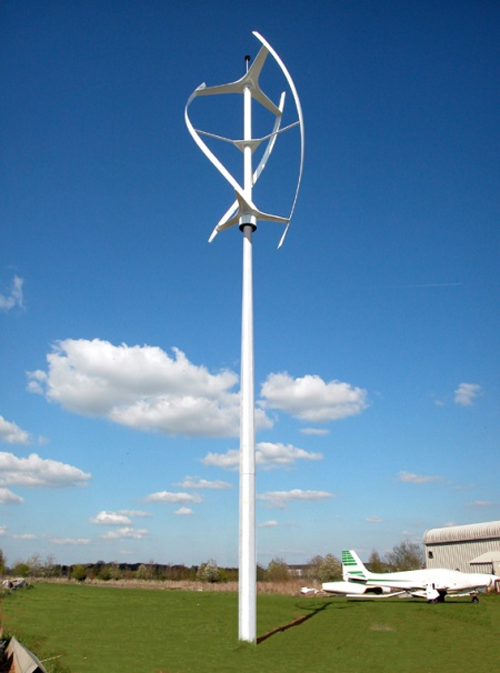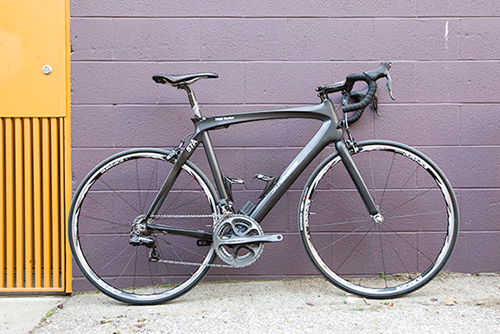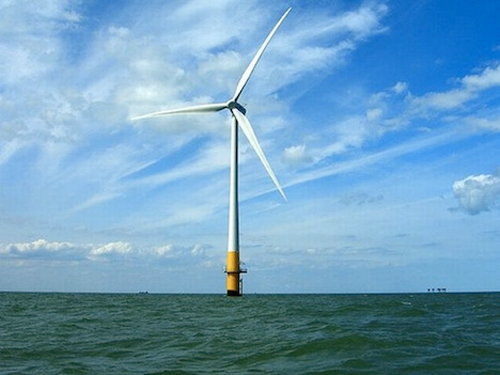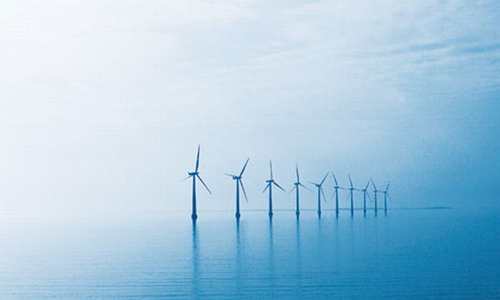Ten wind turbines.
 If wind turbines are a turn-on for you… (more…)
If wind turbines are a turn-on for you… (more…)
 If wind turbines are a turn-on for you… (more…)
If wind turbines are a turn-on for you… (more…)
Description:
A comfortable pedal powered bicycle with weather protection.
Emphasis is made on automotive qualities in the design, to attract non-previous cyclists used to cars and motorcycles.
Another selling point to attract more people riding a bike (particularly here in Europe) is weather protection – ThisWay has a roof.
Built in composite materials (carbon or flax fiber) and some hydro-formed aluminum, this vehicle is very lightweight (approximately 11-12kg). It has built-in LED lights front and rear, powered by a rechargeable battery obtaining its power from roof mounted solar cells. For minimum maintenance ThisWay’s built-in belt drive is well protected and all cables are hidden within the frame.
The car-like ergonomics offers a riding position lower than a traditional bike to keep a low center of gravity and optimal aerodynamics.
The design has simple controls for ease of use; single hand brake lever and hub gears type Torpedo Duomatic providing Low and Hi gear.
The rear of the frame has a “luggage connector”, where the user plugs-in his/her luggage (e g briefcase, helmet box or rack for shopping bags). The design also benefits from flexibility and comfort for riders of different sizes, as the crankset and seat is adjustable in length/height.
A “hybrid” version (pedal power/electric motor) is possible and additional battery pack plugged-in into the luggage connector will extend the range further.
Although this design is more expensive to manufacture compared to its traditional rivals, it is still just a fraction of the price of a car and virtually zero in running costs…
Motivation:
There are roofed bikes out there on the market already such as rickshaws, recumbents, HPVs (Human Powered Vehicles)/velomobiles etc., so covered bikes do exist since a long time but the challenge is to design a functional and desirable bicycle that even appeals to non-previous cyclists.
It makes sense for a commuter bike here in Central and Northern Europe to offer some degree of weather protection for improved comfort. Instead of creating a totally enclosed design similar to other HPVs/velomobiles risking the user to feel isolated, a more open design will allow a higher degree of interaction with the surroundings.
Winner Bicycle Design “commuter bike for masses” design competition. See the Bicycle Design list of finalists .
Designer: Torkel Dohmers
WHAT DO YOU THINK OF THIS CONCEPT? — comment below.
 Shimano, a company that’s been at the forefront of the cycling-component industry for decades, has got a new product. It’s an electronic shifting system that forgoes mechanical cable for electronic impulses and servomotors. (more…)
Shimano, a company that’s been at the forefront of the cycling-component industry for decades, has got a new product. It’s an electronic shifting system that forgoes mechanical cable for electronic impulses and servomotors. (more…)



MINI announced that they’ll be giving up to 500 test drivers the opportunity to test drive the new no-carbon footprint electric MINI E before it’s released.
The diminutive 3-door MINI E is powered by a 100% electric motor (hybrids are for wusses), and still manages to go from 0 to 62 mph (100 km/h) in about 8.5 seconds. While a top speed of 95 mph (152 km/h) isn’t going to break any world records, it’s plenty for anyone who doesn’t spend much time on the autobahn or the race track.
The car gets its juice from over 5,000 individual power cells, joined together to form a single composite battery. At peak, the motor can crank out 204-horsepower and 162 ft/lb of torque – not too shabby for an electric car.
With a cruising range of 150 miles (approx. 240 km), the MINI E should be fine for heading back and forth to the office, grocery, or any other short haul local destination.
If you live in Southern California, New York City or New Jersey, you could be selected to be one of the lucky early test drivers. For your chance to test out the new MINI E, head on over to MINI Space and fill out the form for more information on applying.
Producer: Mini

How much brainpower does it take to blog? I know! Let’s ask a plant! Well, it seems that’s possible in Japan where a plant has
been wired wired with sensors that pick up bio-electrical signals and converts the signals into data that’s then translated into Japanese. Are you following this?
A typical entry? “It was cloudy today. It was a cold day.” Sounds like the plant could Twitter.
It’s a university engineer’s project about communicating with plants. Let’s do the right thing here and point this engineer to Facebook.
See for yourself at plant blog

This running feature began in 2008 to develop a story on the state of wind
turbine design. The most current news was inserted February 2010 below.
(top two photos) The world’s largest wind turbine ( in 2008 ) is was the Enercon E-126. This turbine has a rotor diameter of 126 meters (413 feet).
October 2008
The E-126 is a more sophisticated version of the E-112, formerly the world’s largest wind turbine and rated at 6 megawatts. This new turbine is officially rated at 6 megawatts too, but will most likely produce 7+ megawatts (or 20 million kilowatt hours per year). That’s enough to power about 5,000 households of four in Europe. A quick US calculation would be 938 kwh per home per month, 12 months, that’s 11,256 kwh per year per house. That’s 1776 American homes on one wind turbine.

These turbines are equipped with a number of new features: an optimized blade design with a spoiler extending down to the hub, and a pre-cast concrete base. Due to the elevated hub height and the new blade profile, the performance of the E-126 is expected to by far surpass that of the E-112.
One of the more unexpected charms of driving through the Spanish countryside is the proliferation of windmills, especially in the windier, higher plateau areas in the north of the country. We’re not talking about charming medieval ones that Quixote took for giants either — Spain ( below two photos ) is rapidly becoming one of Europe’s leaders in green energy, and broad acceptance of wind power is a big part of it.


In 2007 Spain’s wind power production record was 27% at the time. That seemed like a lot, but a week ago, Spain’s wind turbines produced 40.8% of total demand, or 9,862 megawatts of power.
There’s a catch, though. The previous record was 10,032 megawatts, but that was 28% of total consumption because it happened during a week day and demand was higher. So this new record is a relative record, while the previous one stands as the absolute best in electricity produced. Still, it’s impressive and we hope that others will pay attention and realize that it can be done.

February 2010 ( left ) norway plans to build the world’s most powerful offshore wind turbine like this in 2011.

With a rotor diameter of 475 feet and a height of 533 feet, the 10-megawatt prototype will be roughly three times more powerful than ordinary wind turbines currently in place, hoping the new technology will increase the profitability of costly offshore wind farms.
What if there’s too much wind?
The turbines are built to catch the wind. But what happens if there is too much wind?
There are new generators that are being developed that will better withstand turbulent wind at the same time capable of generating more megawatts. The photo and video below shows one such design.
Global warming has moved our attention to alternative energy generation. We are going to explore what is out there. We want to look at both engineering and aesthetics. Help us grow the story through your comments.
Resources:
treehugger
grist
trends updates


It’s summer in our hemisphere. Long days. Warm weather. Spending more time outdoors. Here is a innovative product that you make yourself at the beach or on a picnic — the cutlery! What fun!
The cutlery (Do!) and an extension cord (Thrush-In) that stores nicely in its own felt container is designed by Arihiro Miyake. The utensils are fashioned by hand and you also make that fashion statement. The designer labels the cutlery disposable but we propose the environmental statement. Throw them in the dishwasher!.
These are just some of the items found in New York mid-May. The main draw was the International Contemporary Furniture Fair at the Javits Center, but there were many off-site events to go to. One was the Hardcore Finnish Design exhibit featuring 20-plus Finnish designers. (more…)

The world’s first eco car show opened at the Eden Project in the UK last week. Let’s discover which type of green motor we’re most likely to be driving in the future.
Love them or hate them, cars are not going away. But road transport accounts for a fifth of our carbon dioxide emissions in the UK, so it’s time to transform the way we buy and use them.
The good news is that in the UK the government’s King Review of transport tells us we can reduce road transport CO2 emissions by a massive 80% by 2050 if we start buying the right vehicles now and take our old bangers off the roads. Now, the technology is out there and our Sexy Green Car Show brings it to you.
Traditionally, environmental organizations have not had much to say about cars, except to try and persuade people not to use them. But at Eden, based in rural Cornwall, people are acutely aware of a dependence on cars. For many it’s just not practical or affordable to travel another way. (more…)
High-design. Electric. 50-state approved (USA).
After quite a bit of tweaks, good and bad press the FDA finally blessed the Tesla in January 2008 and this red (green) car can go on sale. The car won’t solve the world problems, at least not this particular car — $100K — but it is a start.
Tesla is probably doing it right as they are a small company. Start with a small luxury — sport market and then move to the mass market. The big auto makers will probably beat them to a mass market electric.
Tesla says it’ll churn out 40 of the $100,000 cars per week. So put your name on the list. And there may be perks down the road too. In Norway if you drive an electric car you can drive in bux/taxi lanes, get free pass in toll booths, have parking near the entrance of large stores.
Interestingly at $100K this one is actually cheaper than most low end luxury cars. (more…)
It’s been a week since Earth Hour 2008. So we looked around to see what happened then, and if
anything since…

A student told us Google went black! Good for them. This is how we envisioned a black Google.

The normal Chicago skyline at bottom.
This taken from the Chicagoist…
Earth Hour officials indicate last year there were 2.2 million who participated in a one-hour effort to bring awareness to energy conservation. Yesterday, they estimated that number was around 10 million. In Chicago, the Sears Tower, the John Hancock, the Wrigley Building, and the Tribune Tower dimmed decorative lights, while 500 McDonald’s throughout Chicagoland turned off their golden arches. In the theatre district, marquees went dark, and Elphaba, the witch from “Wicked” turned out the lights with a dramatic “spell”. Navy Pier’s iconic ferris wheel went dark and nearly every store on the Magnificent Mile turned out their lights. (more…)
All content ©2007 > 2024 DesignApplause
Notifications